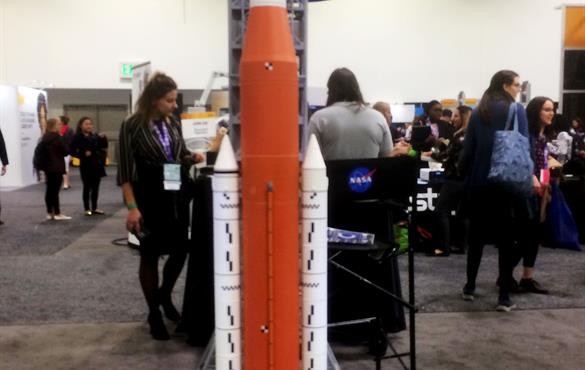SWE Blog: Powerful Women at NASA
Dominique Meyer, treasurer of SWE, shares a few of the lessons she learned from the most powerful women at NASA at the 2018 SWE annual conference

Earlier this semester, the Washington University in St. Louis chapter of the Society of Women Engineers attended the organization's annual conference in Minneapolis. As part of this series, select members share lessons they learned that they feel could benefit the entire engineering community.
I tighten the straps around my virtual reality headset and eagerly sit down to experience a live rocket launch. I turn to my co-pilot and acknowledge his thumbs-up before taking control in the pilot seat. I spiral down the exterior of the rocket, catching a glimpse of the open plains surrounding the launch site. Five … four … three … two … one … and this giant hunk of metal is blasted into the clear blue sky, leaving behind the NASA career booth and heading towards the unknown world above.
For centuries, NASA has pushed the limits of human knowledge by exploring intergalactic worlds. Many of these projects are fundamental to our understanding of how physical phenomenon manifest back on Earth. Most recently, NASA pioneered the Helios 2, a solar probe designed to complete 24 close range fly-bys of the sun to observe behavior from a new perspective. But, perhaps even more astonishing than the numerous initiatives leading the international exploration of space are the professionals behind the program. This year at the SWE National Conference, I had the opportunity to attend a panel of four high-ranking business women at NASA and hear their stories in one of the most highly regarded research organizations in the world.
They discussed topics ranging from specific career experiences to gender disparity in the workplace. Each story featured different challenges and showcased unique talents, often starting with technical experience with an evolution towards a balance of both business and technical skills. One leader described her late-graduation from college around age 30 after working in the trucking industry for years. Another panelist described her eventual switch to the managerial side of the organization after feeling maxed out in her technical roles. However, each story could be characterized by a certain non-linearity that allowed time to play out career development and concisely define a passion. For women in any discipline, it is difficult to claim a seat at the table. At the intersection of STEM and business, these challenges are amplified making it even more difficult to rise to the top. However, these four women were able to overcome these barriers and gain recognition as highly distinguished managerial leaders at NASA.
While these women chronicled their success stories, the casual and light-spirited tone of the conversation struck me. Here I was listening to the deputy director of engineering at NASA Johnson Space Center crack jokes in front of an audience of several hundred people. My preconception involved very serious, very awkward engineers; however, I was met with a group of friends that I would love to grab coffee with.
With this, I realized something that is so important to bring into your career and life: You are not defined by your qualifications. Women have been qualified for engineering careers for decades and still face extremely unbalanced representation in the workforce. This problem should motivate women to assert themselves in STEM fields, however, it is still important to remember your drives and motivations outside of engineering. We must maintain our positivity, our sense of hope and community, our ability to love and have a family and come back from gender discrimination. And we must also ensure that the problems of the workplace do not dictate our happiness, personality and passions.
Only one woman on the panel admitted that her goal from the beginning was to lead the most important table at NASA. The other women followed their careers down sideroads towards other interests and possibilities. They were curious and passionate for their work, and through this process of self-discovery and internal awareness, they were able to distinguish themselves as leaders. Finding your passion and professional role may take time. It may take new degrees, new careers, new companies. It will require patience and hard work. But, especially as women, it is important to confront this tumultuous path courageously with the understanding that women can and should earn a spot at the table. There will be co-workers that type your abilities based on your gender. There will be situations of inappropriate sexual behavior. But now is the time for women in STEM.



